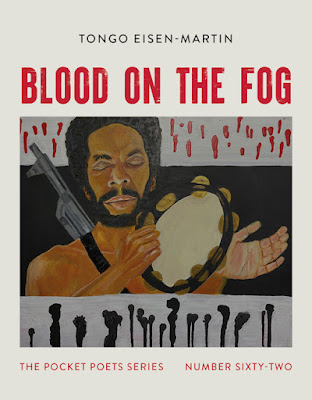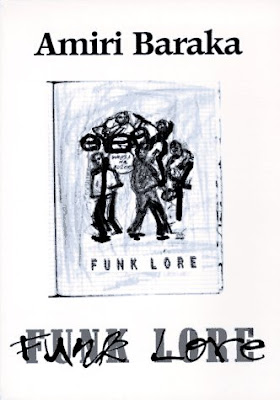BLOOD ON THE FOG by TONGO EISEN-MARTIN
Reading by Rev. Dr. T.C. Marshall
Blood on the Fog by Tongo Eisen-Martin
(SF, City Lights, 2021)
including interview material, by Dr. T.C. Marshall
Grounded in more than just another poetry scene, the works of San Francisco Poet Laureate Tongo Eisen-Martin have risen from a life of focused activism in resistance against racist state violence. His poetics developed in engagement, and his engagement with language is clearly part of that. To do the work of poetry in this way requires clear objectives but also an openness to the dialectical play of the real world.
That play is stripped to its basics in an essay published at proteanmag.com in June, 2020, under the title “Alienation for my Peers”:
So what we have is normalized, institutionalized, legislated, and well-armed insanity that solidifies the position of the ruling class. And the only way to deal with this torrential insanity is with clear, sober, well-reasoned, theory-generated, praxis-tempered, committed organization (Waiting Behind Tornados for Food, 74).
These two opposing poles may seem strictly “political” and simply divided to some, but their interplay enlivens Eisen-Martin’s poetry. To read his most recent book, Blood on the Fog (City Lights Pocket Poets Series #62), is to see the maturity of an approach that engages with both poles and puts them in their places. This approach to poetry was nurtured, enlivened, and challenged by poetry scenes in which the writer took part nearly as much as by the work he has done on the political scene. It fits Fred Moten’s claim about the importance of studying “how blackness and imagination are compact, in reconstructive flight from imposition, its sovereign operations, which keep on taking their incalculable toll” (Stolen Life ix). Blood on the Fog uses the positive force of this study to present lived blackness and lively imagination in combination with images of hegemonic whiteness and the killing violences. “The Cycle of Black Mercy” speaks of both forces to expose the situation:
“Trying to protect children with poems / protect these store runs”
[as if to say: when you send the kids out for milk, will they be coming back?];
“welcome to the mild bourgeoisie
revolution street fairs /our weariness”
[reminding us that bourgeois reformism celebrates itself against people’s dignity];
“make your greenback ruling-class confetti / art somewhere in this”
[elsewhere he writes, “Money is propaganda for claiming one does not belong to a military side” (20), and that applies to Arts monies];
[and then a moment of poetry’s weaknesses as strength:]
“Gradually, the poem becomes decently empty
You know, be weak
Let the ability to write slip
until only one fingertip is left on the handle
then, in a flash, return with a slave castle in a cup of change
[which images how History repeats itself in various guises but never goes away]
And the poem ends with a mockery of the mercies of the management:
“Ladies and gentlemen:
We assure you that tonight’s entertainment is not judging you …
We paid them … really well”
(87-89)
It is that flash that is the moment of poetry doing its work of linkage between what has happened, what is happening, and what must happen. This poetry uses the dialectical play inherent in our social contradictions, exposing them from all sides. It also employs a dialectic between images of concrete objects and abstract terms to bring out meaning, as in “their trendy latches locked before God” (13) as an image of gentrification.
In “I Make Promises Before I Dream,” the poet says “I might as well be an activist” (67) as though he had a simple casual choice. It is much more a causal choice. On the Poetry Foundation website in a recording from “Poetry Now” in December, 2018, Eisen-Martin explains that this line reflects how we exist among social contradictions and are thereby impelled to be pro-active against the state and its violences.
His three “essays” published at poetryfoundation.org in June 2019, another from there and the one from proteanmag.com in 2020, along with fourteen poems from the three American books, are presented in a British “greatest hits” volume called Waiting Behind Tornados for Food (London, 2020). The essays clarify a well-reasoned stance that there is “a foundation of violence” in white hegemony (14), the “well-armed insanity” mentioned above. They also speak about the poetry and its labor. In “Collateral White Skin,” we get the following applied poetics statements:
“Poetry is every step of the way from idea to practice. Our revolutionary … praxis and our art subtitle each other. Both evolve or atrophy together.”
“Poetry is a play on perception … ; specifically, what your mind’s capacity for and use of language can manufacture when you don’t have to follow the bounds of physical and/or social reproduction. This perception, as catalyzed by the opportunity for de-crystallizing hegemonic identity, is where liberation begins.”
“Poetry occupies the strangest place in reality. A convergence of paradoxes where reality can simultaneously only be perceived and only be produced; … proof of the fact that the system is … the aggregate of coercion and consent.”
(Waiting 15-16)
The poems of Blood on the Fog, too, make assertions about poetry and the poet. The first one has this ending:
After today, I have never been a poet before
A little brother watches his big brother’s friends
They lean rifles on shelter walls
They agree with me and call it literature
It’s a simple matter this revolution thing
To really lie to no one
To keep nothing godlike
To write a poem for God
(15)
Throughout the three books, Tongo Eisen-Martin is thinking about his art and craft and the place of poetry in or as revolutionary action. Even this brings out contradictions like a poem for God with nothing “Godly” about it. Eisen-Martin is always looking for fresh poetic means while applying those in his grasp.
In our e-mail exchange of December 2023, he characterized the present moment as “that foothills phase, where I’m looking for new ways to go about writing or evolving species of poems from previous work.” The ongoing struggle for an applied poetics is ever-present. Eisen-Martin said his “current style was built in an obscurity where poetry was not my primary praxis, literally at a kitchen table in Jackson, Mississippi. Nightly writing just for the muscle of it. And so, the basics I stick to now do not really require a scene to evolve.” However, he gives much credit to scenes that did once strengthen his work. He says he was “heavily influenced by the mecca that was the Nuyorican Poetry Café” where he “was schooled directly and indirectly about the potentials of craft.” It was not so much styles to emulate as “a standard of self-actualization and facilitation of energy” that he learned there. The poet put it in an image: “To see a coliseum floor you would not last 30 seconds on (to put it dramatically militaristically) was a blessing of tutelage.” He focused on another lesson about “the importance to truly inhabit a poem, let a poem inhabit you; while you and the poem more haunt the stage than perform.” From there, he said, “I could go on and on, but again I would emphasize the standards of power that were not tied to adventures of recognition, but rather how much of your soul you could make hurricane.”
That storm, that lightning in a bottle, is a perfect image for the poetry of Blood on the Fog and Tongo Eisen-Martin’s other work in writing, performance, and recording. “Scenes,” he said, “are important, healthy, and necessary if they can transcend the hegemony of the times.” However, frustratingly, “fascism abounds and art practices, individual and collective, are just as diligent conduits of these warped normalizations of absolute power.” Eisen-Martin was clear: there are no guarantees; a poetry scene can be just a haven for “niche literary aesthetics” and individualisms. “I think because a lot of scenes are not rooted in the pirate ships of buildings captured during deindustrialization (i.e. the Nuyorican Poetry Café or World Stage), there is a discontinuity with the mass imagination” and imminent collapse. “New scenes pop up, but performing for gentrifiers is to build a sand castle.”
In his sharp essay “Alienation for my Peers,” Eisen-Martin quotes Marx on how emancipation calls for humans to “become a species-being” who has “organized their own powers as social powers” rather than alienating them into mere political powers (qtd on 75). That would be the “alienation” brought upon us by those who “maintain their control over the material reality of society through implanting and maintaining cultural passivity through violence and coercion” (74). It pushes us toward the forfeit of our social connection, our “undercommons” (as Moten and Harney call it), our each other or we may push back. The poet’s response to this surreal splitting of the world is delineated by Fred Moten in Stolen Life thus: “The double burden of our atmosphere has a double edge whose interstice we inhabit, with which we are pre-occupied, as anti-occupation” (ix). The doubling appears in the poetry as the braiding of little real things with big ideas, of concrete and abstract, of mythic and actual heroic ideals, of History and moment. “Third in the World” wraps up Blood on the Fog with these lines:
Lay your plan out on this lightning
Make your poems the corner pocket of men
I’ve greeted the Blues itself
america may clean my dead body, but will never include me
there goes the poet –killing without killing– don’t mind this
… this painting of your language
may I be a meaningful lynching
a crow’s passing
good and dead by the afternoon
(106-7)
The Yoruba Orisha Shango’s lightning and hints of his dialectical double-axe are right there. He was in the poem fighting for justice à la Joe Louis just a page before that:
Like a radio prize fight featuring Shango himself
A real hand sweeps the land of racism
May I return to the ground
May I make progress with the gun
My Mother Emanuel
(105)
The reference to “Mother Emanuel,” resistance leader Denmark Vesey’s church in Charleston and site of recurrent hate-crime attacks, puts the third of three key tools in that “real hand”: groundedness in proper analysis, “progress with the gun” and how to handle both ends of it, and that sense of church that is not the building or the steeple but the community: “open the doors, and see all the people.” That is where Tongo Eisen-Martin and his poetry are at work.
*****
Rev. Dr. T. C Marshall is retired from community college English teaching. He now works as a critic, poet, performance artist, literary scholar, Alzheimer's caregiver, and fritillary farmer in San Diego.



Comments
Post a Comment